In what may become Act Two for the North American “shale revolution,” some operators are returning to their mature shale wells to refracture, or restimulate, the rock to accelerate the rate of production and enhance the ultimate recovery of trapped hydrocarbons. Refracturing is not a new technique and has been applied for many years in tight rock and vertical wells. But now producers want to apply refracturing to a large inventory of unconventional wells suffering from low production because of ineffective initial completions. Refracturing could also serve as a countermeasure against the characteristically steep decline rates of shale wells. A few years after coming on-stream, most horizontal shale wells produce at a fraction of their initial rate, yet large volumes of oil and gas remain in the rock that could be produced through refracturing.
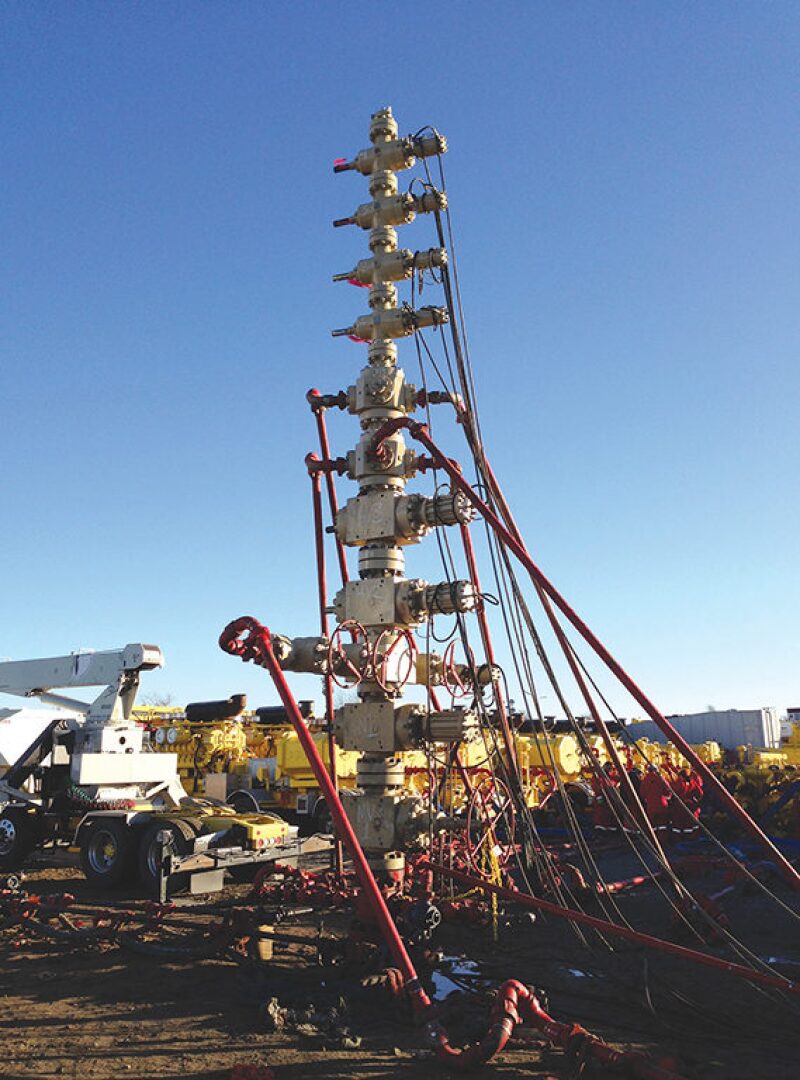
Those involved expect shale well refracturing activity in the United States and Canada to increase steadily as companies figure out how to optimize the mechanics of the operation. Their optimism is based on some early success stories, and the sheer number of possible refracturing opportunities that exist. “Over these next 2 years, the industry will be sharpening their pencils on how and where they are going to (refracture), and then they are going to do it because the potential is tremendous,” said Ibrahim Abou-Sayed, founder of a Houston-based company called i-Stimulation Solutions that offers upstream engineering and consulting services.
However, some companies are sitting it out until newer technology overcomes some of the challenges involved with refracturing to make it an easier operation to carry out. Tim Leshchyshyn, founder of a Calgary-based company called FracKnowledge that maintains a database of fracturing information, characterizes refracturing as a “large, complicated topic” that needs more research and development to become a reliable technique. “For many of the candidates that need to be refractured, the industry is short on technology to do so,” he said. “I think there are some tools out there that help, but there is still a lot of room for technology development to make it easy and highly successful.”
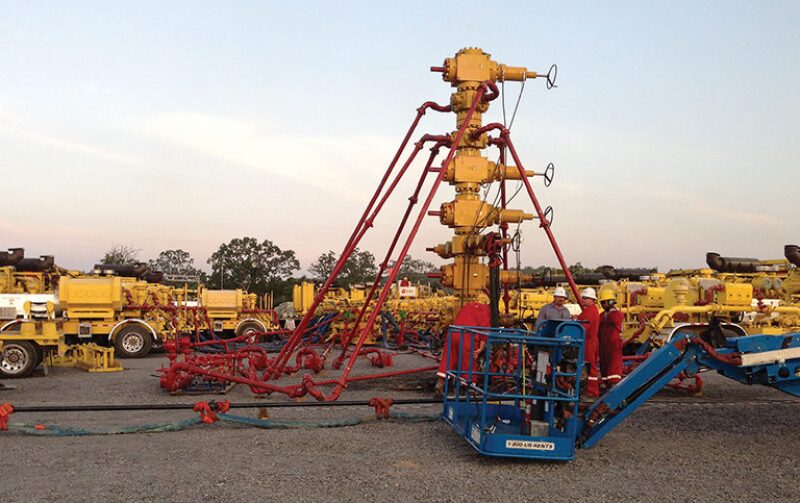
The companies exploring refracturing, such as BP, which recently used the method to double production from a set of maturing horizontal shale gas wells in Oklahoma, are increasing their margins by fine-tuning the methods and criteria they will rely upon to select refracturing candidates. In a case study, BP concluded that “incremental gas rate and reserves can be economically added by the refracturing of horizontal shale gas wells,” and without “significantly damaging the baseline production rates.”
The criteria depend very much on the characteristics of the play itself and how the well was initially completed. In many cases refracturing candidates will include wells completed early on in a play’s development. The oldest wells present opportunities to apply knowledge that comes later in a play’s life, such as the pay zone’s true extent and how far apart to space fracture clusters.
In wells where an insufficient amount of proppant was placed to optimize production, refracturing provides operators with another shot at getting the right amount of proppant into a fracture zone. Refracturing can also be used to remedy wells in which the proppant inside the fracture network is damaged or clogged by the wax or asphaltene deposits or scale buildup. The rock itself can in fact be the weakest link in shale wells as it has a strong tendency to react to drops in reservoir pressure by closing in around the producing fractures, inhibiting the flow of oil and gas.
Refracturing Plays
Because they count among the most widely explored, the Eagle Ford, Haynesville, Bakken, and Barnett shales are expected to be the plays with the most to gain from large refracturing campaigns. Some of the major players in those areas are already in the process of transitioning from pilot programs to commercial programs.
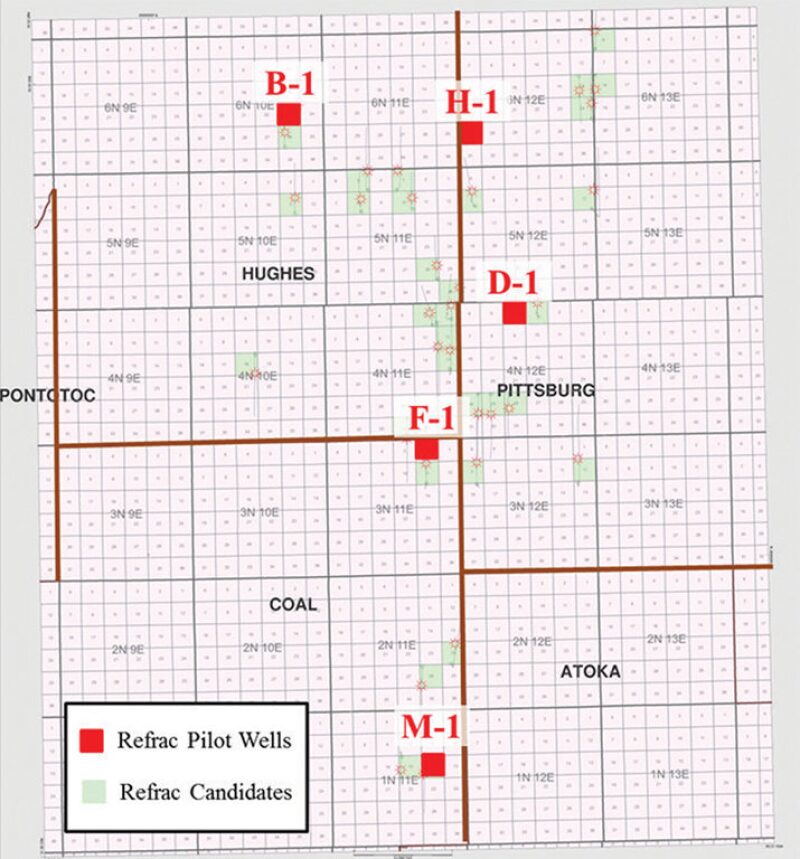
Others are just getting started. Devon Energy, one of the first operators to exploit the Barnett shale in Texas, will begin a refracturing pilot program later this year. The pilot program will attempt to establish the best operational practices and will likely target horizontal wells with wider-than-average perforation clusters, or fracture zones. “These early laterals that were fractured had pretty widely spaced perf clusters,” said Jeff Dahl, a completions engineer at Devon. “Now we recognize, after producing thousands of these wells, that we can narrow down that cluster density.”
Plays where heavy drilling activity started later, such as the Marcellus shale in the northeastern US, will correspondingly take longer to become hotbeds of refracturing activity since many of the wells are too young for intervention. Working with its US clients, i-Stimulation Solutions has built refracturing criteria for several hundred horizontal shale wells. The company estimates that after eliminating wells that may not withstand the pressures involved with refracturing, between 80% and 90% of them will remain prime candidates. After analyzing a client’s well data from a single shale play, Abou-Sayed believes, “There are hundreds and hundreds of wells (in that play) that can be re-energized with refracturing.”
Taking into account that the well has already been drilled and casing has been run, the company estimates that the refracturing costs could be between 50% and 100% of the well’s original completion cost, which is typically around half the total cost of a horizontal well. The payback comes by way of accelerated production and an increase in the overall amount of recoverable hydrocarbons. Therefore, a major consideration for refracture candidates should include an evaluation of the well’s oil or gas in place to determine its ultimate potential.
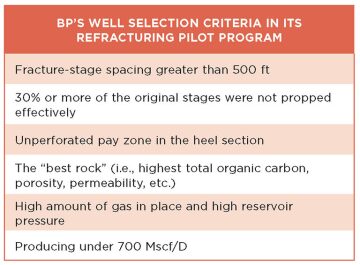
Fielding the Candidates
Over the course of several months last year, BP completed a five-well refracturing pilot program in the Woodford shale play in eastern Oklahoma that averaged a twofold increase in sustained gas production. The company launched the pilot program after learning that operators in the same play were netting similar increases in production through refracturing. The refractured wells came from a stock of dry gas wells that BP acquired from Chesapeake Energy, and that had been producing for 5 to 6 years. For the pilot wells, BP selected those producing volumes of gas less than 700 Mscf/D. “The reason for selecting such wells was that there remained some uncertainty in the outcome—and we did not want to impact production while proving the concept,” said Sam French, a senior reservoir engineer at BP’s North American gas business unit. French was the project manager of the team that executed the pilot program and presented the case study at the SPE Hydraulic Fracturing Technology Conference in The Woodlands, Texas, in February.
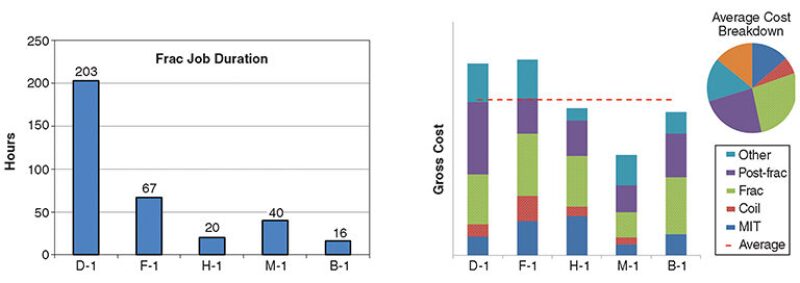
Based on newer geologic data, BP determined that the top of the Woodford play was significantly higher than where Chesapeake had assumed. This meant that a number of the acquired wells in BP’s Woodford holdings had around 700 ft of unperforated pay zone in the first part of the lateral section known as the heel. To Chesapeake’s credit, French noted that the company had been new to the Woodford and had not “figured out” the play at the time of development. Four of the five wells that BP selected for the pilot program had additional pay at the heel, which provided a relatively easy opportunity to refracture and restimulate using the plug-and-perf technique. Another goal of the BP program was to refracture rock through existing perforations that were not stimulated properly during the original completion. The company determined that the first four stages in one of the wells placed, on average, only 20% of the target amount of proppant. “We see that as a big opportunity,” French said. “If we can go in and we can refrac those same stages, through those old perforations, and place more proppant in them, then we believe we can obtain additional gas reserves.”

The pilot program was marginally economic, partly because BP encountered more operational complications than it had anticipated, but per-well costs were reduced with each successive well after the first two. BP has since refractured seven more strongly performing wells, six of them in January, and reported that the economics continued to strengthen and improve. While extensive post-treatment production data was not yet available, French said indications were that production from the latest set of wells was not negatively affected by refracturing. Going forward, BP will focus on refracturing those wells with a higher 30-day initial production (IP) rate because the quality of the rock appears to directly correlate with gains made through refracturing. “From what we are seeing, not unsurprisingly, you appear to achieve an enhanced benefit from your better wells,” French said. “Now that we have treated quite a few wells, we are fairly comfortable with refracturing higher rate wells and that will be the next set of wells we are going to address.”
The Refracturing ProcessTo carry out the pilot refracturing project in Oklahoma, BP brought in a workover rig a month before the refracturing operations. The workover rig was used to pull the production tubing from the well and set a composite bridge plug below the top of the Woodford shale formation. A mechanical integrity test was then carried out with the workover rig to ensure the casing could hold up to the pressures involved with refracturing. The company then brought in a coiled tubing unit a week before the refracturing date to add perforations using a tubing-conveyed perforating system, after which a fracturing spread was used to perform the stimulation treatment in as many as 10 stages. While pumping the stages, BP dropped between 30 and 50 rubber-coated nylon diverter ball sealers per stage into the well to plug producing perforation clusters and divert pressurized fracturing fluids to the perforations needing treatment. Ball sealers have proved to be an effective way of diverting fracture stages sequentially; however, they can also introduce a number of complications. When a coiled tubing unit jammed up inside one well for a 6-day period before coming loose, the company believed that the rubber-coated balls may have been to blame. So it switched to biodegradable balls that serve the same purpose as the rubber-coated balls but reduce the risk of sticking coiled tubing, and the jamming problem did not reoccur. Once the refracturing jobs were completed, BP began with the well flowback and cleanout operations, and then used a workover rig again to run the production tubing back in. BP has now ditched diverter balls in these types of operations and is instead using a biodegradable polymer for diversion in refracturing jobs. The polymer biodegrades in a matter of days depending on time, temperature, and water flow. “We feel like it is a more effective diverting agent than the balls,” said Sam French, a senior reservoir engineer at BP. “We are getting higher pressure increases when we drop it and it hits the perfs.” He added that with a biodegradable polymer, operators can choose to stop mid project if they drop too much of the diverting agent and in pump down a solution of 5% sodium hydroxide and heated water to accelerate degradation of the material. After just 6 hours, 95% of the agent should be dissolved. An added benefit to using a biodegradable diverter agent is that it requires less equipment compared with using diverter balls. |
Among the added benefits discovered by BP during its pilot program is that refracturing can minimize the impact on older wells from what are known as “frac hits,” which occur when a new adjacent well is being hydraulically fractured and its pressurized fluid intersects with the fracture network of an offset well. In extreme situations, this can cause the completed well to blow out, but more commonly, it results in a loss of production. One of the refractured wells in BP’s program was bounded by two wells drilled about 900 ft away and completed just before the refracturing operation. BP expected that without refracturing, the older well’s production rate, which was 300 Mscf/D, would have been significantly “reduced or even halted by frac hits.” Instead, when the well was brought back online, the production rate soared to 1.3 MMscf/D. Backpressure from new wells in the area decreased the rate sharply to 900 Mscf/D, but as the line pressure stabilized, production went back up and the well was producing 1.1 MMscf/D several months after refracturing. BP plans on expanding its refracturing operations slowly, so it can analyze its operations as it goes, and introduce more technology and well surveillance. One of the next steps for the company is to begin a refracturing pilot program in the Eagle Ford shale.
Responding to Deformation
Based on its analysis of unconventional reservoirs, i-Stimulation Solutions has determined the wells that stand to benefit the most from refracturing are those drilled in rock with above-average pressures and higher clay content (but less than 50%). Until around 2009 to 2010, US and Canadian shale gas and oil producers were eager to achieve the highest IP rates to turn a profit as quickly as possible. Abou-Sayed thinks this rush to cash in contributed to production management issues and accelerated the production declines seen in shale wells across the US and Canada. “People initially came in, opened up the wells to get the highest rates, and then damaged the wells,” he said.

While higher-pressure wells are often the strongest producers, Abou-Sayed pointed out that those wells will experience the largest drops in pressure. And when a high-pressure well is allowed to flow freely, the deformation of the fracture surface and the rock matrix is more severe than it would be in a managed production well. As the rock deforms, the hydraulically fractured surface area and conductivity created in the initial completion shrinks, reducing the drainage radius of the fractured network and, thus, lowering production rates. This geomechanical phenomenon is referred to as creep. Wells drilled in shale rock with high clay content are also more susceptible to the effects of creep because clay is highly ductile.
Abou-Sayed said that operators are now more aware of this problem and are implementing new well production management practices that will produce at a slower rate. “When you draw down the wells too quick to get a high IP, you put a massive load on the rock and it creeps faster,” he said. “So what we have seen is when you choke back the wells, and control them to a very low drawdown, they last longer and produce more.”
Weighing the Risks
FracKnowledge estimates that as many as 25,000 horizontal shale wells are potential candidates for refracturing in Canada alone. So far, however, the company has only tracked approximately 20 refracturing operations in Canada and around 100 in North Dakota. “It is not being done a whole lot right now,” said Leshchyshyn. “Where there have been pockets of success is where there have been a lower number of technological barriers present.”
For each well drilled, there is a minimum rate of production that it needs to maintain before crossing the economic threshold and becoming marginally profitable. Before reaching that inflection point, by a few months or a year, Leshchyshyn said that operators need to decide whether or not they are willing to invest significant sums of money, to the tune of USD 250,000 to USD 3 million per well, on refracturing. “It becomes a pretty interesting economic proposition,” he said, “But it doesn’t have to be wildly productive to still be profitable since the initial drilling, completion, and tie-in costs have been covered.”
One reason for the low refracturing activity in Canada and North Dakota is that multistage hydraulic fracturing had not taken off in a large-scale manner until 2009 and so wells are just now reaching the point at which low production is becoming a problem. Some of the risks associated with refracturing involve running tools inside a restricted wellbore. Once the remains of initial downhole tools are removed or milled out, many of the plugs or seats that are used to isolate fracture zones for pressurized stimulation leave behind a small diameter restriction on the inside perimeter of the liner or casing. These restrictions can be problematic for systems such as coiled tubing cup tools or packers because they reduce the internal diameter of the casing and can damage the refracturing tool’s sealing elements. In horizontal wells with lateral lengths of a mile or longer, some of the deepest stages cannot be reached by coiled tubing due to a physical limit on string size. Because of such issues, Leshchyshyn said operators are still hesitant to earmark capital for refracturing. “It is still easier to drill a new well,” he said. “You can go drill a new well, you can frac it, get some production out of it, tie up more land and reserves, and wait for the technology to catch up for the refracturing market.”
Refracturing Tooling
Interra Energy Services began making downhole tools specifically for refracturing less than a year ago in response to the increasing interest of its operator clients in refracturing and restimulation. The difference between the two operations, according to Interra, is that restimulation techniques are more broad-based than refracturing, and can include the injection of acids and other elements to increase production by removing blockages, such as scale.
Interra’s tool, called AccuStim, can be deployed on coiled tubing or jointed pipe and uses a packer to isolate the fracture zone behind it, and a cup system to isolate the area in front of the tool. The company originally produced a 5.5‑in. and a 4.5-in. diameter version of the single trip system; its newest version has a diameter of 3.5 in. The slimmer tool was developed in response to operators’ desire to reach inside wells that used earlier versions of the ball-drop systems, which feature a tighter diameter than later systems. “We know of no other company that has that configuration,” said Will Gardner, who has a technical background in well completion and is Interra’s manager of business development.
When a ball-drop completion method is used to open sleeves during fracturing, a seat with a diameter smaller than both the ball and wellbore is left behind, creating an obstruction for intervention operations. “One of the biggest things that limits refrac and restimulation, is what the initial completion was,” said Gardner. “We have seen a lot of companies that have used a ball-drop or profile system right off the bat, and they may have seen some great efficiencies up front in the completion, but now they have a wellbore full of profile that needs to be drilled out before they can be refractured.”
Armed with many lessons learned and new technology, Interra is seeing operators design new well completions with fewer obstructions to facilitate refracturing and other workover operations that may be required later in the well’s life. In wells where that is not the case, and the internal diameter is more limited, Gardner said his company is applying foresight to its next generation of completion systems to make it possible to re-enter wells without milling out plug seats or where there are tight constrictions.

